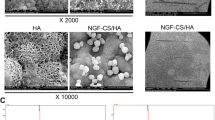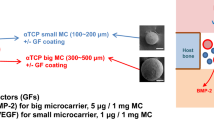Abstract
In craniofacial surgery, bone is needed to augment misshapen areas and to fill gaps during repair of congenital anomalies and injuries resulting into bone deficiencies. Examples of conditions requiring bone tissue include missing alveolar bone in cleft palates, bony nasal pyramid defects following removal of fistulous tracts or cysts and defects following removal of sinus and mandibular tumors. Moreover, maxillofacial neurosensory deficiencies may be caused by various surgical procedures, such as tooth extraction, osteotomies, pre-prosthetic procedures, excision of tumors or cysts, surgery of TMJ, and surgical treatment of fractures and cleft lip/palate. Therefore, a tissue engineering approach to craniofacial surgery has a crucial importance: the use of various composites with osteoconductive ceramics, polymers, bioactive factors, cells, or a combination of them, offers the possibility of rapid tissue regeneration and integration with the host tissue. In this study, a composite consisting of two well-known biomaterials, collagen/hydroxyapatite (Col/HAp), was used as a drug delivery device for neurotrophin – nerve growth factor β (NGF β). This delivery device, enriched with neurogenic-osteogenic factor, was analyzed in vitro and in vivo. It was implanted into calvaria defects of 20 Wistar rats, weighing 200–250 g. Implants were left in place for different periods of time. Controls were as follows: (a) contralateral defect without any implant; and (b) contralateral defect implanted with composite without NGF factor. The rats were euthanized after 30 days, and the implant sites and explants were examined clinically, histologically, SEM and histomorphometrically. Our results evidenced stimulation of periosteal and endocortical woven and lamellar bone formation, with increases in bone mass and decreases in bone marrow. We found that NGF enhanced the remodeling activity in the intracortical region, and induced an increase in the intracortical cavity number and area by the end of the study. In vitro results were in line with in vivo ones. We believe that the composite proposed in this study has considerable advantages in tissue engineering and is very suitable as a biomaterial for the filling of irregular defects in maxillo-facial surgery. Two areas of clinical research will be impacted by this system. The first is pharmaceutical research on drug delivery and high-throughput screening of neurotrophic-osteogenic compounds. Transplantation research is the second area that will benefit from the system.
Similar content being viewed by others
References
E. Alsberg, E. Hill and D. J. Mooney, Crit. Rev. Oral Biol. Med. 12 (2001) 64.
R. E. Marx, E. R. Carlson, R. M. Eichstaedt, S. R. Schimmele, J. E. Strauss and K. R. Georgeff, Oral Surg. Oral Med. Oral Pathol. Oral Radiol. Endod. 85 (1998) 638.
A. H. Reddi, Nat. Biotechnol. 16 (1998) 247.
M. Lind, Acta. Orthop. Scand. Suppl. 283 (1998) 2.
M. Lind, Acta. Orthop. Scand. 67 (1998) 407.
P. Lundberg, I. Bostrom, H. Mukohyama, A. Bjurholm, K. Smans and U. H. Lerner, Regul. Pept. 85 (1999) 47.
I. Auffray, S. Chevalier, J. Froger, B. Izac, W. Vainchenker, H. Gascan and L. Coulombel, Blood 88 (1996) 1608.
Y. T. Konttinen, S. Imai and A. Suda, Acta Orthop. Scand. 67 (1996) 639.
K. Asaumi, T. Nakanishi, H. Asaha, H. Inoue and M. Takigawa, Bone 26 (2000) 625.
E. L. Hohmann, R. P. Elde, J. A. Rysavy, S. Einzig and R. L. Gebhard, Science 232 (1986) 871.
M. Hukkanen, Y. T. Kontinnen, S. Santavirta, P. Paavolainen, X. H. Gu, G. Terenghi and J. M. Polak, Neuroscience 54 (1993) 969.
A. Bjurholm, A. Kreicberg, L. Terenius, M. Goldstein and M. Schultzberg, J. Auton. Nerv. Syst. 25 (1988) 119.
A. G. Hardy and J. W. Dickson, J. Bone Jt. Surg. 45 (1963) 76.
A. A. Freehafer and W. A. Mast, ibid. 47 (1965) 683.
J. A. Gillespie, ibid. 36 (1963) 464.
W. Calvo, Am. J. Anatomy 123 (1968) 315.
U. K. Akal, N. B. Sayan, S. Aydogan and Z. Yaman, Int. J. Oral Maxillofac. Surg. 29 (2000) 331.
A. Bjurhalm, A. Kreicbergs, E. Brodin and M. Schultzberg, Peptides 9 (1998) 165.
P. Lundberg, I. Lundgren, H. Mukohyama, P. P. Lehenkari, M. A. Horton and U. H. Lerner, Endocrinology 142 (2001) 339.
L. Aloe, L. Bracci-Laudieri, S. Bonini and L. Manni, Allergy 52 (1997) 883.
U. H. Lener, Oral. Surg. Oral Med. Oral Pathol. 78 (1994) 481.
M. Yada, K. Yamaguchi and T. Tsuji, Biochem. Biophys. Res. Commun. 205 (1995) 1187.
A. Akopian, A. Demulder, S. Ouriaghli, F. Corazza, P. Fondu and P. Bergann, Peptides 21 (2000) 559.
H. A. Maurof, A. A. Quayle and P. Sloan, Int. J. Oral Maxillofac. Implants 5 (1990) 148.
K. S. Tenhuisen, R. I. Martin, M. Klimkiewicz and P. W. Brown, J. Biomed. Mater. Res. 29 (1995) 803.
A. Letic-Gavrilovic, R. Scandurra and K. Abe, Dental Mater. J. 19 (2000) 99.
M. Parfitt, K. Drezner, H. Glorieux and J. A. Kanis, J. Bone Miner. Res. 2 (1987) 595.
R. J. Tamargo and H. Brem, Neurosurg. Quart. 2 (1992) 259.
C. Xudong and M. S. Shoichet, Biomaterials 20 (1999) 329.
J. Benoit, N. Faisant, M. C. Venier-Julienne and P. Menei, J. Control. Res. 65 (2000) 285.
J.-M. Pehan, P. Menei, O. Morel, N. Claudia, Montero-Menei and J.-P. Beniot, Biomaterials 21 (2000) 2097.
F. H. Gage, J. A. Wolf, M. B. Rosenberg, L. Xu, J. K. Yee, C. Shults and T. Friedmann, Neuroscience 23 (1987) 795.
M. E. Nimni, Biomaterials 18 (1997) 1201.
C. H. Kasperk, J. E. Wergedal, S. Mohan, D. L. Long, K. H. Lau and D. J. Baylink, Growth Factors 3 (1990) 147.
W. S. S. Jee and Y. F. Ma, Bone 21 (1997) 297.
Author information
Authors and Affiliations
Corresponding author
Rights and permissions
About this article
Cite this article
Letic-Gavrilovic, A., Piattelli, A. & Abe, K. Nerve growth factor β(NGF β) delivery via a collagen/hydroxyapatite (Col/HAp) composite and its effects on new bone ingrowth. Journal of Materials Science: Materials in Medicine 14, 95–102 (2003). https://doi.org/10.1023/A:1022099208535
Issue Date:
DOI: https://doi.org/10.1023/A:1022099208535




